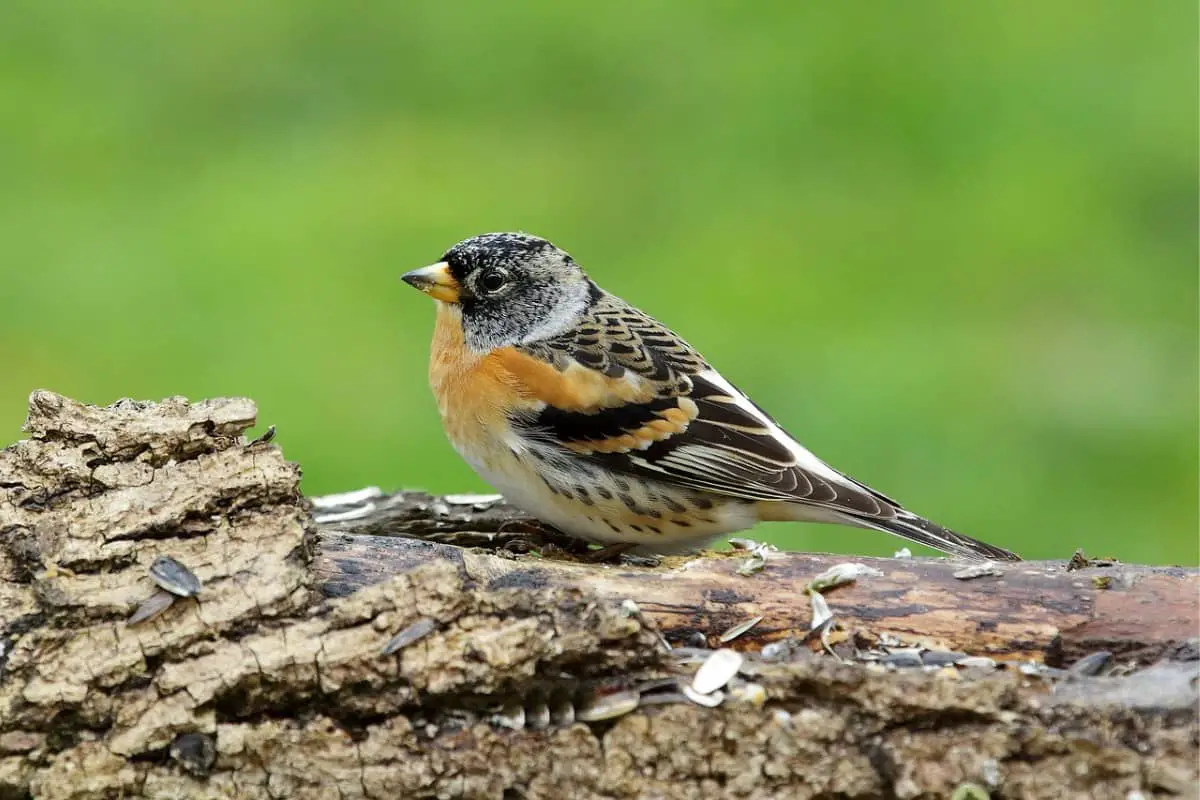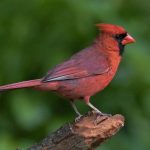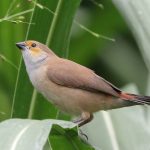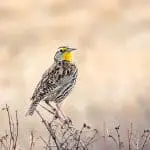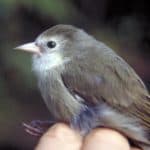Common Name: Brambling
Scientific Name: (Fringilla montifringilla)| Size | Diet | Range in Hawaii | Status in Hawaii |
|---|---|---|---|
| 6 in. - 7 in. | beetles, grasshoppers, and flies | Unkown | Least Concern |
The Brambling (Fringilla montifringilla), also known as the Mountain Finch, is a beautiful and unique bird species that is native to parts of Europe and Asia. With its striking orange and black plumage and melodious singing, this bird is a beloved sight in its natural habitat. However, the species is also known to make appearances as a non-breeding visitor and vagrant in Hawaii, where it is a rare and exciting sighting for birdwatchers.
In this article, we’ll explore the fascinating world of the Brambling, its unique adaptations, and behavior in the wild.
Brambling
Appearance
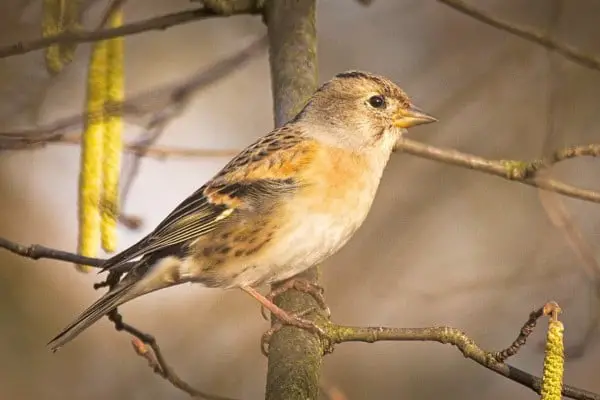
Adorned with a striking plumage, this small passerine bird stands out with its contrasting colors. The male Brambling boasts a vibrant orange breast, contrasting beautifully with its jet-black head and back. Its wings showcase a distinctive white patch, adding to its allure.
Meanwhile, the female Brambling exudes an elegant charm with its warm-toned plumage and subtle streaks. Standing at around 5.9 inches (15 centimeters) in length, the Brambling may be small in size, but its visual splendor is truly remarkable.
Diet
Delve into the culinary preferences of the Brambling and uncover its fascinating diet. This small passerine bird has a penchant for seeds and insects, forming the core of its nourishment. During the breeding season, the Brambling relishes in feasting on a variety of seeds, including birch, alder, and spruce.
Nesting
This avian architect prefers to construct its nest on the ground, hidden amidst dense vegetation or in the shelter of low shrubs. Using an intricate combination of twigs, grass, and moss, the Brambling carefully weaves together a cozy cup-shaped structure for its eggs. The female Brambling takes on the responsibility of incubation, diligently keeping the precious eggs warm and protected.
Once hatched, the young Bramblings are nurtured with a diet rich in insects and seeds, carefully provided by both parents. Witness the wonders of avian parenthood as the Brambling ensures the survival of its offspring through dedicated care and attention within the hidden realms of their ground-nest.
Behavior
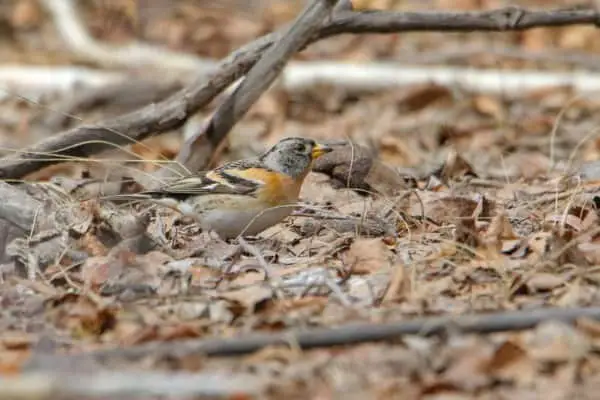
As winter approaches, vast flocks of Bramblings embark on an epic transcontinental journey, traveling from their breeding grounds to more temperate regions in search of abundant food sources. These migratory gatherings can number in the thousands, creating awe-inspiring spectacles in the skies. Their synchronized movements, akin to a graceful dance, leave observers mesmerized.
What sets the Brambling apart is its distinct social behavior. While many birds exhibit hierarchical structures, Bramblings have a unique egalitarian social system. Within the flock, there are no leaders or followers. Each Brambling acts independently, yet cooperatively, seamlessly navigating through the ever-changing environment.
Observing Bramblings forage in winter is a sight to behold. They descend upon forests and fields, meticulously combing through the vegetation in search of seeds and insects. Despite their individual focus, they maintain close proximity to one another, forming a cohesive mass that undulates with a harmonious rhythm. This remarkable coordination allows them to efficiently exploit resources while minimizing the risk of predation.
The Brambling’s behavior also extends to its melodious songs. Males use their vocal talents to communicate during courtship displays, creating a symphony of chirps, whistles, and trills. These intricate songs are not only a means of attracting mates but also serve as a form of social cohesion within the flock.
Intriguingly, Bramblings showcase a high level of fidelity to their wintering grounds. Year after year, they return to the same locations, reuniting with familiar faces and establishing strong bonds. This fidelity, combined with their enigmatic behavior, makes the Brambling a subject of ongoing scientific study, with researchers seeking to unravel the mysteries of its remarkable migratory journeys and social dynamics.
Habitat

The Brambling exhibits a unique habitat preference. During breeding, it thrives in dense coniferous forests. In winter, it flocks to agricultural fields with cereal crops, where it forages for seeds and grains. Protecting these habitats is vital for the survival of this captivating migratory bird.
Range
The Brambling has ventured far beyond its usual range, making a rare appearance in Hawaii. This non-breeding species, typically found in northern Eurasia, surprised birdwatchers with its documented sightings on Kure in October 2014. The presence of the Brambling in the Pacific Basin hints at a remarkable historical connection.
These unexpected visits may hint at a historical connection, potentially mirroring past colonization events that shaped the unique diversity of Hawaiian finches. With its distinctive presence, the Brambling adds a touch of excitement to Hawaii’s avian landscape.
Conservation Status
The Brambling (Fringilla montifringilla) is a migratory bird with a favorable conservation status. Currently, it is categorized as a species of least concern by the International Union for Conservation of Nature (IUCN). This designation indicates that the Brambling’s population is stable and not facing significant threats or declines.
Interesting Facts
1. Wintering range
Bramblings have an extensive wintering range that stretches from Western Europe to East Asia. They can be found in countries such as the United Kingdom, France, Germany, Japan, and China, among others.
2. Hybridization
Bramblings are known to hybridize with other finch species, particularly the closely related Chaffinch (Fringilla coelebs). These hybrid individuals display a mix of characteristics from both parent species.
3. Nomadic movements
While Bramblings are primarily migratory birds, some individuals may exhibit nomadic movements within their wintering range. These movements can be influenced by food availability and local weather conditions.
4. Nest parasitism
Bramblings may occasionally fall victim to nest parasitism by cuckoos, particularly the Common Cuckoo (Cuculus canorus). The cuckoo lays its eggs in the Brambling’s nest, leaving the host parents to raise the cuckoo chick.
5. Cultural significance
Bramblings hold cultural significance in some regions of their range. For example, in Japan, the arrival of Bramblings is considered a sign of the changing seasons and is celebrated during festivals and traditional events.
Frequently Asked Questions
1. How long do Bramblings live?
Bramblings have been recorded to live up to 8-10 years in the wild, although their lifespan can vary depending on factors such as predation and habitat quality.
2. Are Bramblings commonly seen in urban or suburban areas?
Bramblings are primarily associated with natural habitats and rural areas, but during migration or wintering, they may occasionally visit gardens, parks, and even urban areas in search of food.
3. Can Bramblings be kept as pets?
It is not recommended to keep Bramblings as pets. They are wild migratory birds that require specific habitats and have complex social and behavioral needs that cannot be adequately met in captivity.
4. Are Bramblings commonly kept in captivity or aviculture?
Bramblings are not commonly kept in captivity or aviculture. Their migratory nature and specific habitat requirements make them unsuitable for captive settings.
